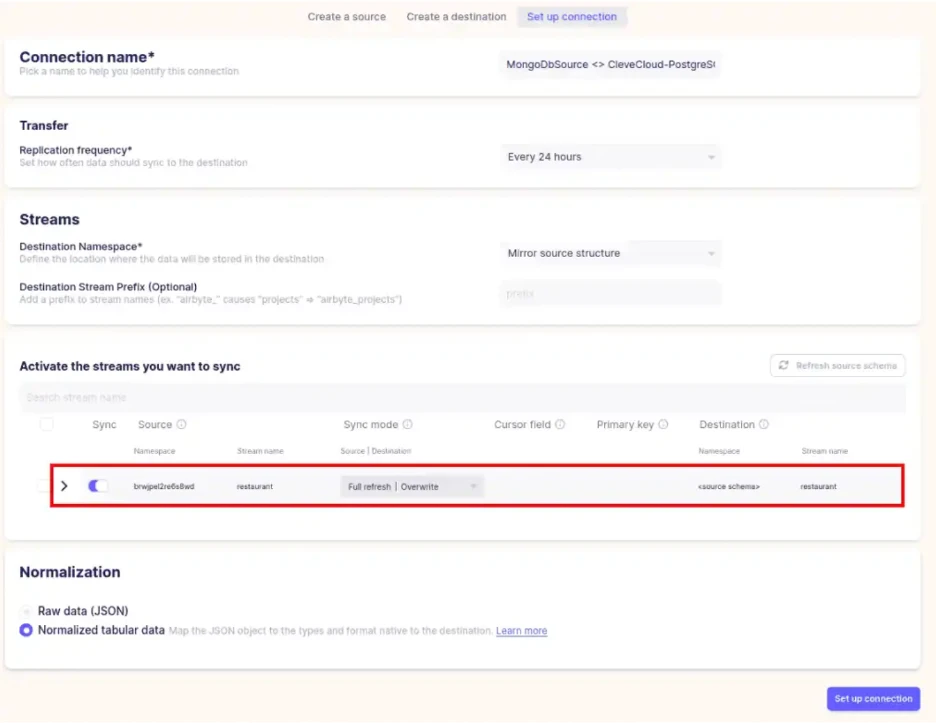The data storage mechanism can change throughout the entire life cycle of an application. It is completely normal when a decision that was used at the start is abandoned in favor of a more suitable one after a couple of years of operation. A common scenario is migrating from MongoDB to PostgreSQL.
In this article, we will talk about the key differences between MongoDB and PostgreSQL, as well as the challenges that arise from changing the DBMS. Additionally, we will cover ways to migrate from MongoDB to PostgreSQL.
What is MongoDB?
MongoDB is a document-oriented database that follows the NoSQL paradigm.
In traditional relational databases, information is stored in interconnected tables. Their structure is rigidly defined, and changing it is not easy. The rows of each table have the same set of fields, and data is processed using SQL queries. In MongoDB, everything is structured somewhat differently. Databases consist of collections and documents - hierarchical structures containing key-value pairs.
The main reasons why companies choose MongoDB include flexibility, scalability, and high DBMS performance.
Flexibility. MongoDB is a cross-platform database that is available for different operating systems and cloud service providers. It efficiently stores and structures both structured and partially structured data, processes large data volumes with low latency. MongoDB supports dynamic schemas and advanced data types (such as arrays and embedded documents). This simplifies application development, allowing organizations to quickly create prototypes without making any changes to existing data models.
Scalability. MongoDB scales horizontally, expanding space for more users or data. It simultaneously increases application performance and reliability by distributing load between multiple computers or data processing centers.
High Performance. MongoDB provides performance of up to 10,000 operations per second per node even on ordinary hardware. In addition, the DBMS has a built-in aggregation structure that can efficiently process complex queries.
What is PostgreSQL?
PostgreSQL is an open-source relational database management system (RDBMS). It is compatible with the Structured Query Language (SQL) and is known for its reliability, data integrity, and active community.
There are several features that make PostgreSQL a more powerful solution than other open-source databases.
ACID compatibility. PostgreSQL complies with ACID requirements thanks to MVCC technology. This makes the system reliable and safe to use, and data is protected from possible failures, errors, and losses. ACID compatibility ensures that transactions will be processed completely or not at all. This prevents errors from occurring during partial execution of an operation and greatly simplifies the recovery of data to a consistent state after a failure.
Scalability. PostgreSQL can scale vertically, using more powerful hardware, or horizontally, by adding more nodes to a cluster. The DBMS supports partitioning, allowing you to split data into smaller pieces and store them on multiple nodes for more efficient processing.
Advanced data types and indexing. PostgreSQL has a rich set of data types, including arrays, ranges, and geometric types, as well as advanced indexing capabilities, such as GIN and GiST, which allow you to efficiently search large volumes of data.
MongoDB or PostgreSQL: Which One to Choose
First, let's understand the key differences between MongoDB and PostgreSQL:
MongoDB is a document-oriented database, while PostgreSQL is an object-relational database.
MongoDB stores data in collections of JSON-like documents, whereas PostgreSQL stores data in tables.
In MongoDB, documents in a collection are equivalent to rows in PostgreSQL.
In MongoDB, you don't need to follow a strict schema definition, since not all documents in a collection may have the same keys. In PostgreSQL, schema definition is strict, as columns in a table are specified during creation.
MongoDB uses the MongoDB query language to interact with the database, while PostgreSQL uses SQL.
Many data management tools rely on SQL and generate complex SQL statements to retrieve the desired set of data from the database. PostgreSQL is excellent at such tasks, as it ensures a reliable enterprise-level implementation that developers can understand.
What about PostgreSQL's drawbacks compared to MongoDB? PostgreSQL relies on relational data models, which are incompatible with the data structures that developers work with in code and that must be defined in advance. This can slow down progress when requirements change, which hinders innovation. MongoDB supports a fast iterative development cycle (data turns into code under the control of developers).
When the application launches, PostgreSQL users must be prepared for a battle for scalability. At some point, for high-performance options, resources will need to be redirected to finding new ways to scale through caching or denormalizing data. In MongoDB, such methods are usually unnecessary, as scalability is built into its own segmentation, allowing for horizontal scaling. After proper cluster segmentation, we can always add more instances and continue to scale.
PostgreSQL supports replication, but more advanced features, such as automatic resource switching, are supported by third-party products. This approach is more complex and can work slower than MongoDB's built-in capabilities.
However, the question is not which is better - MongoDB or PostgreSQL, but rather when it makes sense to use a document-oriented database and when to use a relational database.
For example, "resilience" is often mentioned as a strength of MongoDB (the database is easily replicable and can be broken down into segments at data processing centers). However, a study on the reliability of PostgreSQL and MongoDB revealed that MongoDB has a history of data loss problems. There are detailed reviews of MongoDB reliability conducted by Jepsen, most recently in 2020 (issues #1, #2, #3, #4, and #5). It is obvious that neither PostgreSQL nor MongoDB is perfect, but when it comes to data reliability, PostgreSQL is the more preferable choice.
If you have carefully weighed the pros and cons and determined that a relational database is a better fit for you, the second part of the article is for you. It discusses ways to migrate from MongoDB to PostgreSQL and presents a specific case study.
Integration of MongoDB and PostgreSQL
There are two ways to transfer data from a non-relational MongoDB database to a relational PostgreSQL database:
- Within the framework of a one-time migration of the database.
- Within the framework of the current replication process, where MongoDB is considered the source database and PostgreSQL is the target database.
Let's take a closer look at each method.
Method 1: Manual ETL Process
Moving data between heterogeneous databases usually involves extracting data from the source database, transforming it into a format compatible with the target database, and then loading the transformed data into the target database.
Step 1: Extract data from MongoDB using mongoexport.
mongoexport --host localhost --db productdb --collection products --type=csv --out products.csv --fields name,category,color,brand,description
Here productdb is the name of the database, products is the name of the collection, and products.csv is the output file. The fields of the last attribute will contain the names of the keys that will be exported to CSV. This is important because MongoDB does not support a rigid key structure, and it is possible that not all keys are present in all documents.
It is necessary to ensure that the keys that should be present in CSV are specified. If a document does not have such a key, mongoexport will not give an error. It will simply fill this column with an empty value.
Step 2: Create a PostgreSQL table reflecting the existing structure.
The PostgreSQL table schema used to obtain the exported data should match the structure of the CSV file.
CREATE TABLE products (
id SERIAL PRIMARY KEY,
name VARCHAR NOT NULL,
category VARCHAR NOT NULL,
color VARCHAR NOT NULL,
brand VARCHAR NOT NULL,
description VARCHAR NOT NULL
)
Step 3: Load the exported data into PostgreSQL using the COPY command.
COPY products(name,category,color,brand,description)
FROM 'C:tmppersons.csv' DELIMITER ',' CSV HEADER;
That's it. Although the steps may seem simple, it should be noted that this is a simplified version of the real problem of data migration. MongoDB and PostgreSQL are very different databases, and there are a number of factors that can lead to unforeseen errors in such a migration.
Manual ETL Limitations Related to MongoDB and PostgreSQL Integration:
- In typical usage scenarios, a MongoDB document, and therefore a collection, will have a large number of keys. Since developers can add additional keys on the fly, most MongoDB collections will contain hundreds of keys. Specifying and modifying keys for export will therefore be a significant challenge.
- Since an intermediate file is involved and it contains the entire MongoDB collection, the approach requires developers to have access to an instance with sufficient memory to temporarily store the file.
- In many cases, data copying is not a one-time but a periodic process that continually synchronizes two databases. Therefore, user logic needs to be modified to accommodate scheduling and handling of recurring data.
- For large MongoDB collections that serve production applications, there is a risk that the ETL process will impact the response time of incoming traffic.
Method 2: Codeless Data Integration Platforms
Codeless data integration platforms automate the transformation process to ensure that data types are compatible between the databases they support. They also provide a user interface (UI) for convenient interaction.
Let's take a look at how to perform data integration between MongoDB and PostgreSQL using Airbyte as an example (assuming you have an account).
Airbyte is an open platform for moving data that can be used to set up and manage data pipelines. It integrates with various data sources, applications, and databases.
Step 1. Log in to your Airbyte account.
Step 2. Set up the source connector. On the Airbyte toolbar, click on "New source," then select MongoDB from the list of sources. Next, provide the connection details to your MongoDB database instance, and then click "Set up source."
Step 3. Set up the destination connector. To do this, click on "Destinations" on the Airbyte toolbar, then select "Create destination" and choose "PostgreSQL."
Step 4. Enter the connection parameters and click "Set up destination" to complete the process.
Step 5. Set up the Airbyte connection between the source and destination. To do this, click on "Connections" on the Airbyte toolbar and select "New connection." Choose the source and destination you created in the previous step. Collections in MongoDB will be automatically detected, and we can select the replication mode and frequency.

Conclusion
In this article, we have looked at how to transfer data from MongoDB to PostgreSQL, and before that, we have familiarized ourselves with each database management system and considered the main differences between them.
It should be noted that both MongoDB and PostgreSQL are excellent tools. However, one of them may be more suitable for your needs. We hope that this article will help you choose the most optimal option.


Comments (1)